
|   |

|   |
Raas Leela intersecting Bharatanatyam and Manipuri dance styles - Dr. Nita Vidyarthi e-mail: nitavidyarthi@gmail.com Photos courtesy: Sparsh Studio for Performing Arts January 19, 2023 On a full moon night, Bharatiya Sanskriti Samsad organized a dance performance of Raas Leela away from the usual presentation of adapting a single genre of classical styles, but with the intersection of the Bharatanatyam and Manipuri idioms on the rooftop of high-rise Azimganj House, Kolkata. Presented by Sparsh Studio of Performing Arts, in association with Dhurba Institute of Dance under the ‘Taal Connect’ banner, the projection of the ‘Divya Roop’ (divine existence) of Lord Krishna in Maharaas was at the core of the production, expressed through the two styles often merging into a harmonious whole but mostly in two distinctly identifiable idioms. 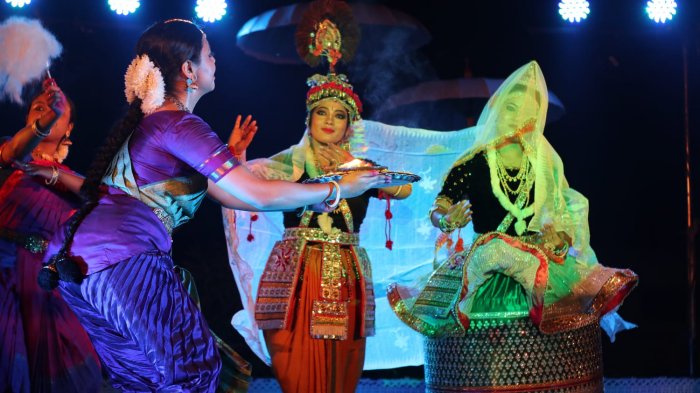 Raas Presented before a packed open air, artistically flower bedecked terrace on a makeshift elevated stage lined with Manipuri Lai-Haraoba umbrellas at the back, the production in an hour and fifteen minutes caught the essence of Manipuri Raas in the choreography of dancer Suman Sarawgi of Sparsh Studio and Sankeertan by Th. Brojen Kumar Singha, an accomplished pung player and his co-drummers from Manipur. Bharatanatyam choreography of Rama Vaidyanathan was presented by the students of Dhruba Institute of Dance under the supervision of dancer Sayani Chakravarty. Maharaas attempts to catch the spirit of Raas Leela, the celebrated dancing of the divine lovers Radha and Krishna performed with the gopis on a full moon night of Kartik (Sharad Purnima) in circles in a specified performance space known as Raas Mandapa. King Bhagyachandra was responsible for creating, composing, popularizing and perpetuating the mystic Raas dance with a spirit of total self-denial and surrender. For the ‘Divya Roop Bhav’, slokas and prose by Dr. Arun Prasad Avasthi were interspersed with the dance sequences. 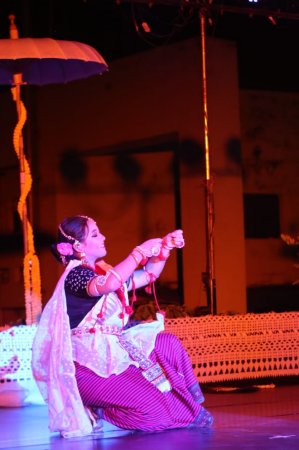 Yashoda After the chanting of the sloka “Hey Jyotipunja tumko pranam” the production commenced in the Manipuri style with the portrayal of navajat or the new-born Krishna being rocked to sleep in the cradle by mother Yashoda. Set to the soulful song “Mere manmandir mein raho merey Devaki Lal”, the gradual growing up of baby Krishna learning to walk by holding mother Yashoda’s hands was depicted effectively by a female dancer through facial expressions and hand gestures while evoking the vatsalya rasa, gently passing on to boy Krishna’s playing with his mother and her then scolding him for going to the banks of the river Yamuna. And the reaction of Yashoda in the song “Mein nahi jayu janani Jamuna teer” without the physical presence of Krishna was very appropriate. All these dramatic introductions of Krishna’s childhood pranks for the actual Raas Leela though redundant was good to watch.  Sayani Chakravarty Conceived by Suman Sarawgi, the production had a planned presentation of alternating the two dance styles with a final combination into a harmonious whole by the two groups of dancers. Bharatanatyam dancer Sayani Chakravarty’s powerful entry and strong execution with several fleeting nritta passages followed by the song “Jab sab laajbhari Brajabasin” and a vibrant Tillana by the Dhruba Institute student group were proof enough for the solid training and grip on rhythm with Sayani standing out for her fine taut dancing which bore the stamp of Rama Vaidyanathan. And then arrived the show stealers - four male Manipuri drum dancers in a thundering recital of Pung Cholam (dancing with elongated drums), a Manipuri Sankeertan choreographed by renowned artiste Th. Brojen Singha. Their presentation found expression in loud blowing of large conch shells, neat lines, fine stances, lovely freeze not to speak of commitment to the art form and the imaginative choreography embellished with lovely bhramaris by Singha - different from the mundane. Baglei (circular floor moves with the pung), aerial spins, energetic dancing and other bounding leaps were moments of exuberance and earned them applause. However, though they arouse excitement and thrill, most of the onlookers were oblivious of the fact that these dances are not acrobatics but presented as a prayer and sacred offering. 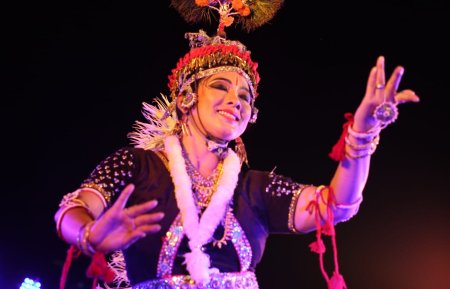 Rujina Lama as Krishna 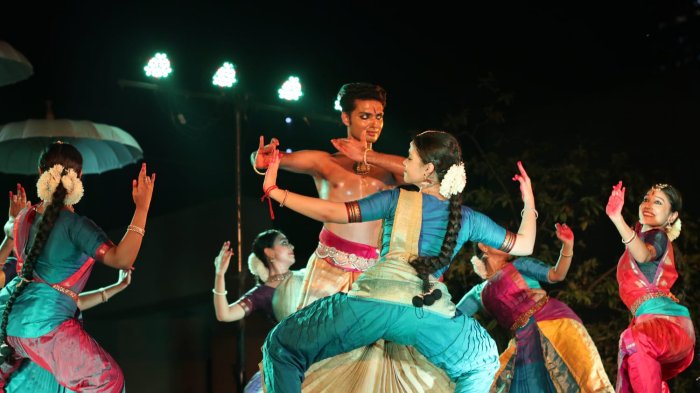 Raas The final sequence was a combined effort of ‘Raas Utsav’ in the two styles, ushered in by song “Sunao murali naad aaj Raas rachao”. Two Bharatnatyam dancers with a male one as Krishna commence with the Raas Utsav sloka “Raasotsava samabritto, Gopi mandala mandalita…”. The closing presentation of Raas with the Bharatanatyam dancers dancing around Radha dressed in the typical Manipuri glittering ‘kumin’ (skirt) and Krishna in the traditional costume showering flowers was a vibrant affair offering fine visual imagery, enhanced by the light effects of Ajay Ranu. Reema Mukherjee as Radha and Rujina Lama as Krishna impressed for their grace and sophisticated dancing. The pung players O. Angousana Singh, Th. Kullachandra Singh, L. Premkumar Singh and Th. Brojen Kumar Singha, all from Manipur, need a special mention for creating magic with their compelling presentation. An enjoyable evening spiced with the bonus of the flower bedecked ambience and the nip in the air. 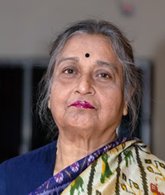 Dr. Nita Vidyarthi is a veteran critic of performing arts and writes on dance, music and theatre in leading publications. |